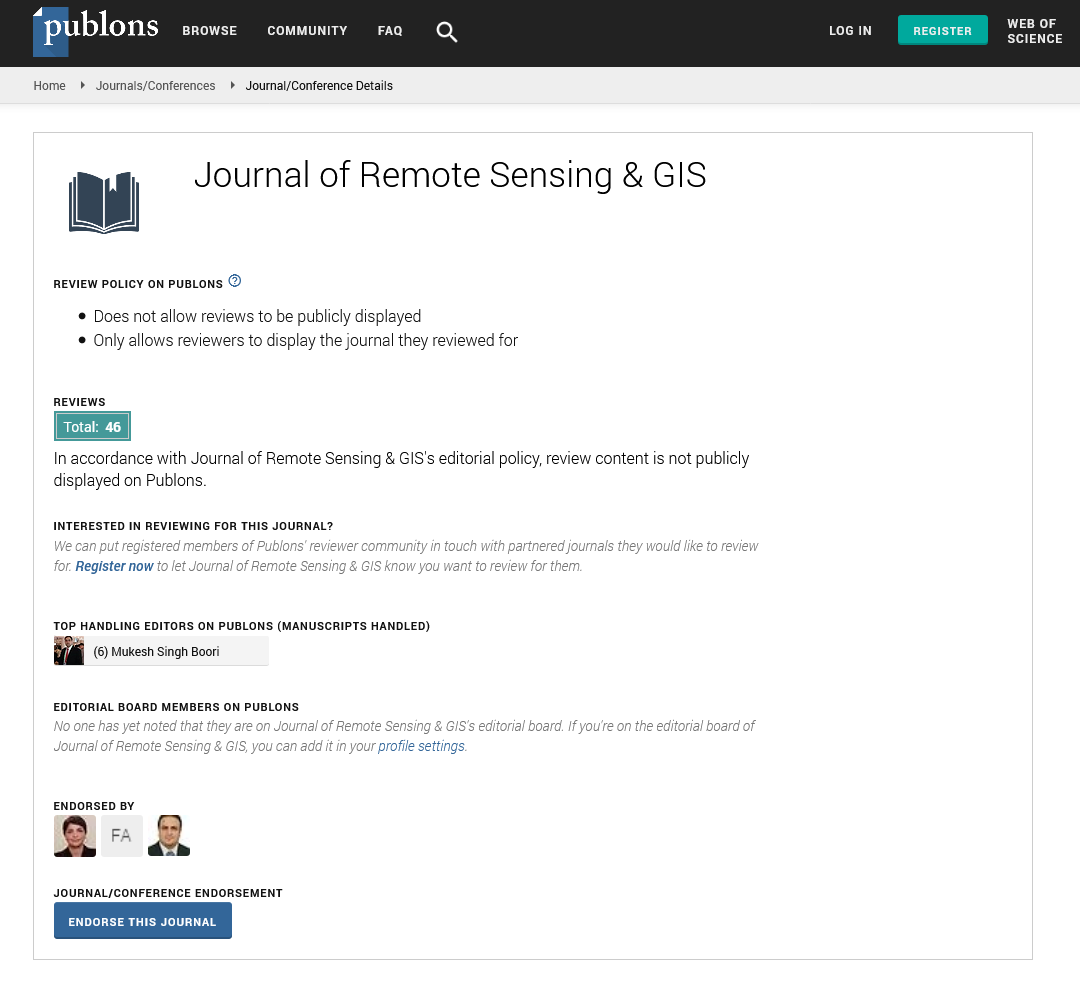Indexed In
- Open J Gate
- RefSeek
- Hamdard University
- EBSCO A-Z
- OCLC- WorldCat
- Publons
- International Scientific Indexing
- Euro Pub
- Google Scholar
Useful Links
Share This Page
Journal Flyer

Open Access Journals
- Agri and Aquaculture
- Biochemistry
- Bioinformatics & Systems Biology
- Business & Management
- Chemistry
- Clinical Sciences
- Engineering
- Food & Nutrition
- General Science
- Genetics & Molecular Biology
- Immunology & Microbiology
- Medical Sciences
- Neuroscience & Psychology
- Nursing & Health Care
- Pharmaceutical Sciences
Commentry - (2024) Volume 13, Issue 3
Remote Sensing and GIS for Disaster Management: Real-Time Applications in Earthquake-Prone Areas
Manton Caputo*Received: 26-Aug-2024, Manuscript No. JGRS-24-26967; Editor assigned: 29-Aug-2024, Pre QC No. JGRS-24-26967 (PQ); Reviewed: 13-Sep-2024, QC No. JGRS-24-26967; Revised: 20-Sep-2024, Manuscript No. JGRS-24-26967 (R); Published: 27-Sep-2024, DOI: 10.35248/2469-4134.24.13.349
Description
Disaster management in earthquake-prone areas is important for minimizing human casualties, infrastructure damage and economic losses. Remote sensing and Geographic Information Systems (GIS) have emerged as indispensable tools in disaster management. These technologies offer real-time monitoring, hazard mapping and post-disaster damage assessment.
Earthquakes are among the most destructive natural disasters, causing extensive loss of life and property. With growing populations and urbanization in seismic zones, the need for effective disaster management has become more pressing. Remote sensing and GIS provide powerful tools for assessing, mitigating and responding to earthquakes.
Role of remote sensing in disaster management
Remote sensing refers to the acquisition of information about an object or phenomenon without physical contact. It involves the use of satellite imagery, airborne sensors and ground-based radar systems to capture data from the Earth's surface. Remote sensing technologies are highly useful in earthquake management due to their capability to collect wide-area data quickly and efficiently.
Pre-disaster hazard mapping
In earthquake-prone areas, hazard mapping is important for identifying areas most vulnerable to seismic activity. Remote sensing, especially with the help of Synthetic Aperture Radar (SAR), enables detailed mapping of geological features, fault lines and tectonic movements. SAR Interferometry (InSAR) has been particularly effective in detecting land deformation, subsidence and uplift, which are early indicators of seismic activity. Combining these data with historical earthquake records helps in risk assessment and preparedness planning.
Real-time monitoring
The integration of satellite-based Global Positioning System (GPS) with remote sensing platforms enables real-time monitoring of seismic activities. Satellite constellations such as the European Space Agency's Sentinel-1 or NASA’s Landsat missions provide continuous Earth observation, allowing scientists to track tectonic shifts in near-real time. These observations help predict potential earthquake events, providing early warnings to reduce impacts.
Post-disaster assessment
Remote sensing plays a pivotal role in post-earthquake damage assessment. High-resolution optical and radar imagery can quickly identify the extent of infrastructure damage, landslides and other secondary hazards such as tsunamis. This information aids in rescue operations, resource allocation and recovery planning. For example, images captured by Unmanned Aerial Vehicles (UAVs) or satellites can map collapsed buildings, blocked roads and displaced populations, facilitating efficient response operations.
Role of GIS in disaster management
GIS is a spatial analysis tool that integrates, visualizes and analyzes geospatial data. In disaster management, GIS helps in creating detailed maps, modeling disaster scenarios and managing resources for emergency response. When combined with remote sensing data, GIS offers comprehensive insights into the spatial and temporal aspects of disaster management.
Earthquake hazard zonation
GIS is instrumental in generating earthquake hazard zonation maps, which divide earthquake-prone regions into different hazard levels. By incorporating remote sensing data with historical seismic activity, land use patterns, population density and infrastructure data, GIS creates detailed risk maps. These maps guide policymakers and urban planners in adopting appropriate mitigation measures, such as implementing stricter building codes or avoiding construction in high-risk zones.
Conclusion
Remote sensing and GIS have revolutionized disaster management in earthquake-prone areas by enabling real-time monitoring, risk assessment and damage analysis. These technologies provide essential tools for minimizing the impacts of earthquakes and improving resilience in vulnerable regions. However, overcoming challenges related to data accessibility, technical expertise and infrastructure is necessary to fully harness their potential in disaster management. Future innovations in AI and cloud computing are likely to expand their role in making disaster response more efficient and effective.
Citation: Caputo M (2024). Remote Sensing and GIS for Disaster Management: Real-Time Applications in Earthquake-Prone Areas. J Remote Sens GIS. 13:349.
Copyright: © 2024 Caputo M. This is an open-access article distributed under the terms of the Creative Commons Attribution License, which permits unrestricted use, distribution and reproduction in any medium, provided the original author and source are credited.

